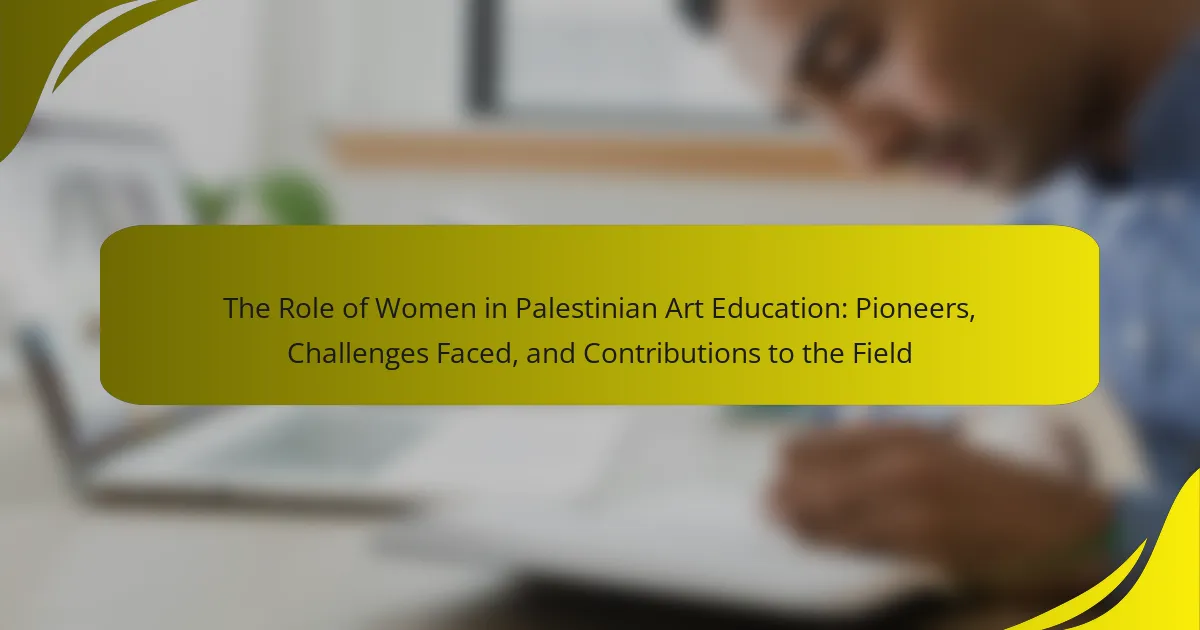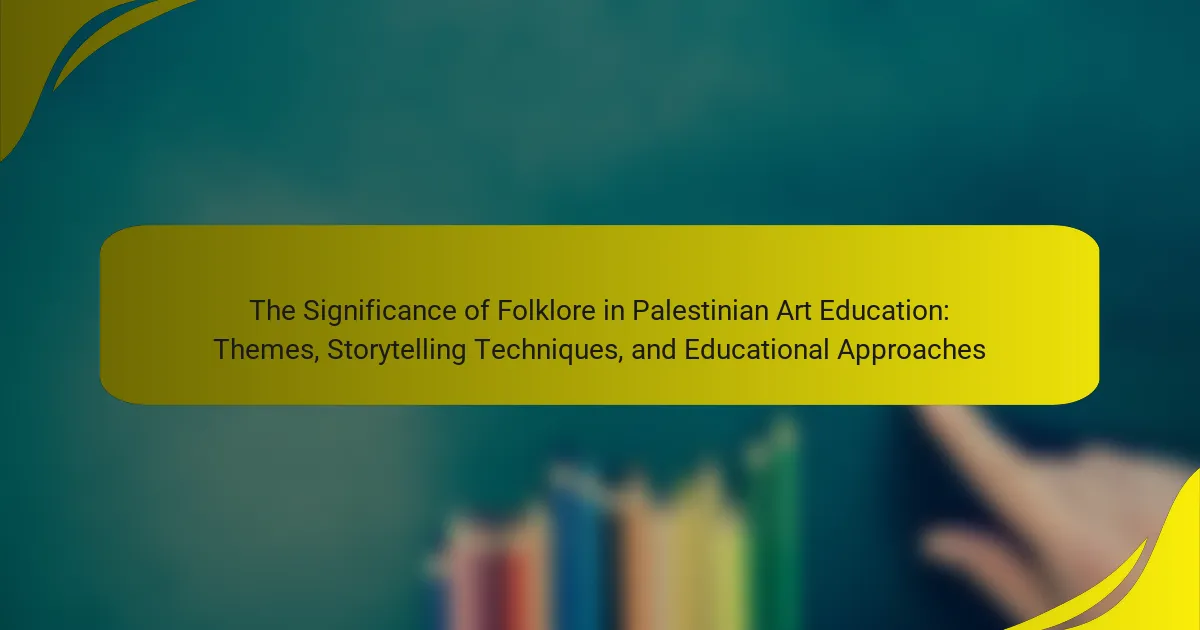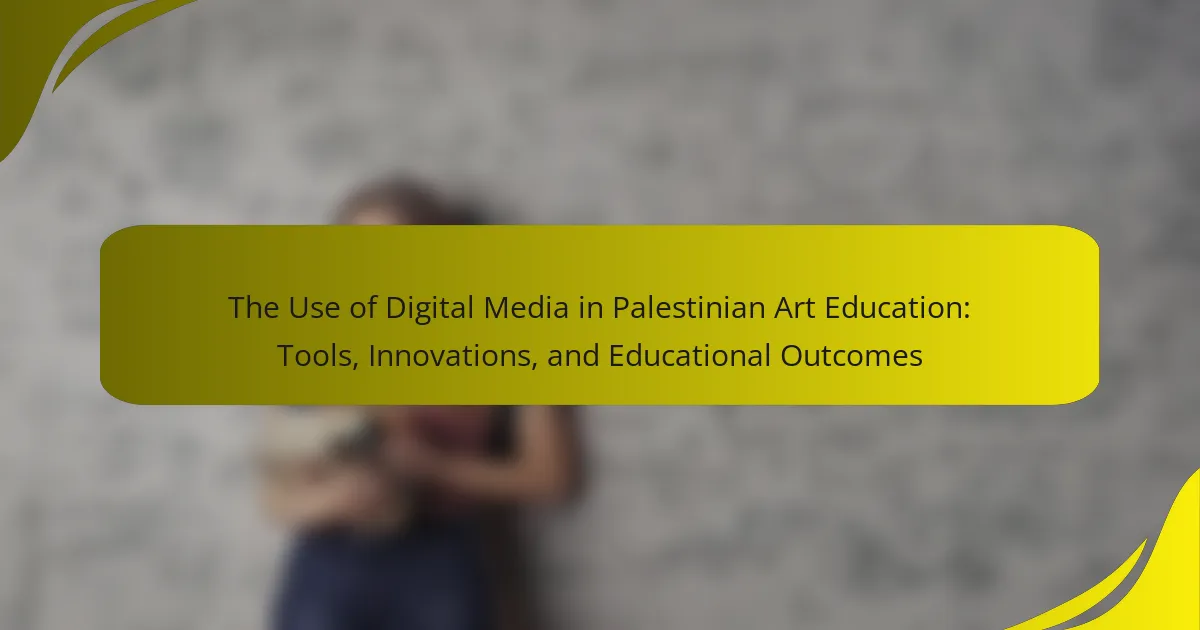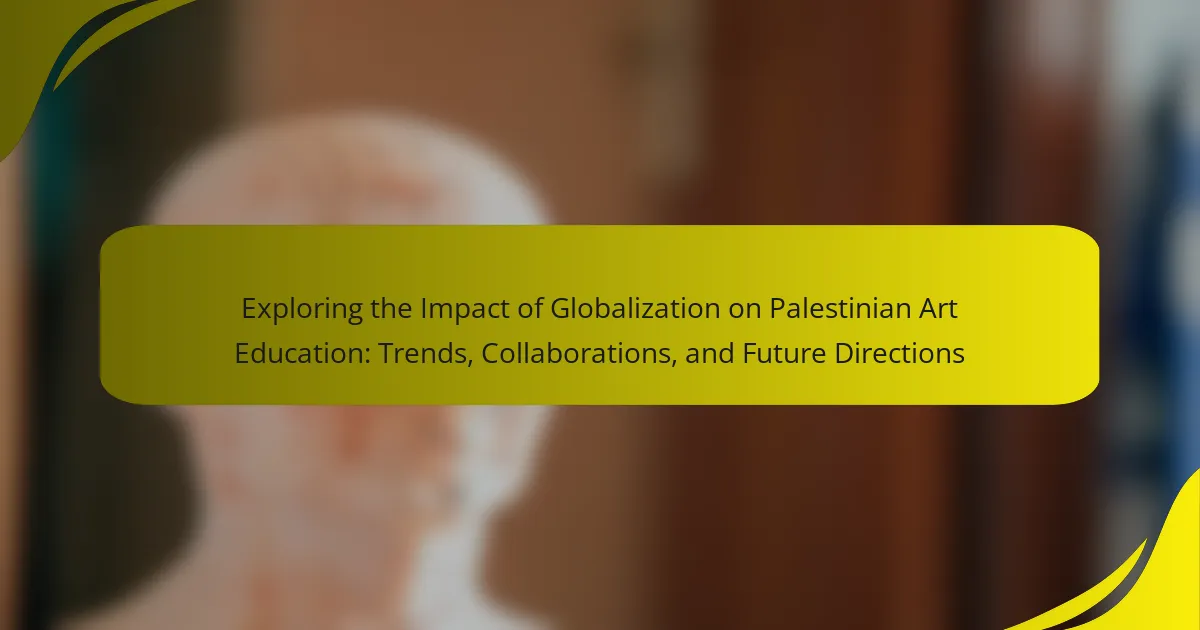Palestinian Art Education and Community Engagement encompasses initiatives that foster artistic expression and cultural understanding within Palestinian communities. These programs include visual arts, music, dance, and theater, aiming to enhance creativity and provide educational opportunities through workshops, exhibitions, and public art installations. Organizations such as the Palestinian Art Court and the International Art Academy play pivotal roles in promoting local talent and cultural identity. Additionally, outreach initiatives for youth and art therapy programs support psychological well-being, while international collaborations facilitate cultural exchange. Community involvement through volunteering, donations, and participation in local events is vital for sustaining these impactful art programs.
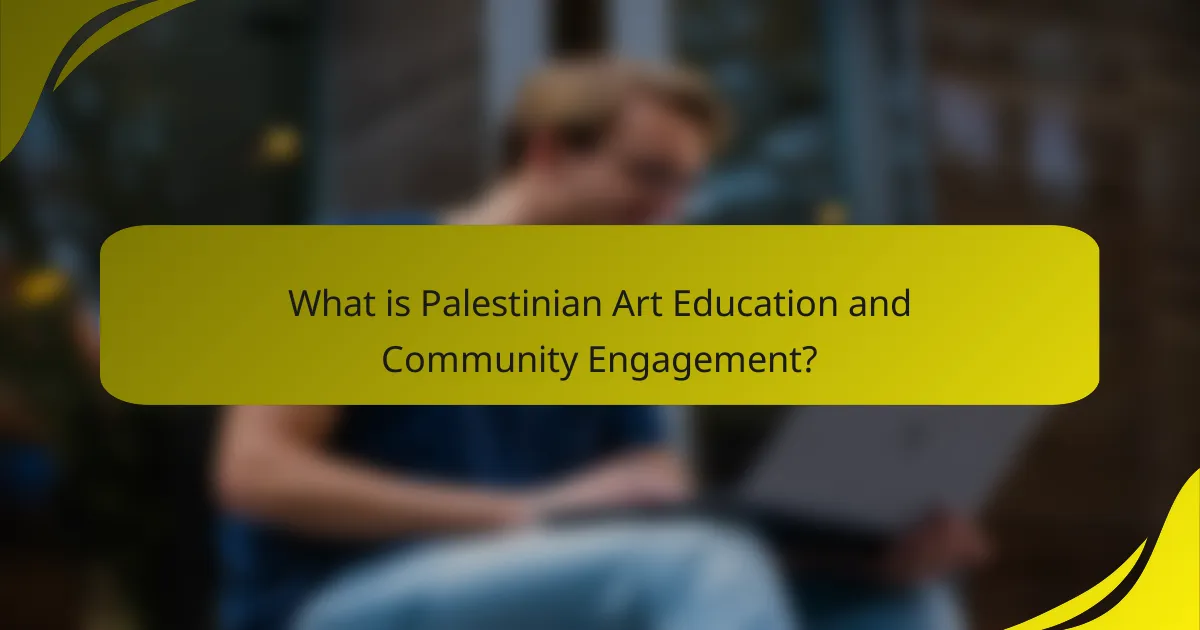
What is Palestinian Art Education and Community Engagement?
Palestinian Art Education and Community Engagement refers to initiatives that promote artistic expression and cultural understanding within Palestinian communities. These programs often aim to enhance creativity and provide educational opportunities through various art forms. They focus on engaging local populations in collaborative projects that foster community bonds. Workshops, exhibitions, and public art installations are common methods used to involve participants. These initiatives also serve to document and reflect Palestinian identity and heritage. Research indicates that such engagement can improve social cohesion and empower individuals. For example, organizations like the Palestinian Art Court and the International Art Academy play significant roles in this field.
How does Palestinian Art Education contribute to community development?
Palestinian Art Education contributes to community development by fostering cultural identity and social cohesion. It provides a platform for self-expression and creativity among youth. Through art programs, participants learn essential skills that enhance their employability. Community art projects often address local issues, promoting dialogue and awareness. Workshops and exhibitions facilitate collaboration among artists and community members. This engagement strengthens community bonds and encourages civic participation. Research indicates that art education can lead to improved mental health and well-being. Overall, it empowers individuals and enriches the community fabric.
What are the key components of Palestinian Art Education programs?
Key components of Palestinian Art Education programs include curriculum development, community involvement, and access to resources. Curriculum development focuses on integrating local culture and history into art education. Community involvement fosters collaboration between artists, educators, and local organizations. Access to resources ensures students have the materials needed for artistic expression. Programs often emphasize critical thinking and creativity. They also aim to promote cultural identity and resilience among participants. These components collectively enhance the educational experience and support social engagement through art.
How do these programs foster creativity and expression among participants?
These programs foster creativity and expression among participants by providing structured artistic environments. Participants engage in various art forms, including painting, sculpture, and performance. This hands-on experience allows individuals to explore their unique perspectives. Collaborative projects encourage teamwork and idea sharing. Access to professional artists as mentors enhances skill development. Workshops often focus on cultural themes, promoting personal narratives. Research indicates that art education improves self-esteem and emotional well-being. A study by the National Endowment for the Arts shows that art participation leads to increased community involvement and social cohesion.
What role do outreach initiatives play in Palestinian Art Education?
Outreach initiatives play a crucial role in Palestinian art education by expanding access and fostering community engagement. They create opportunities for underrepresented groups to participate in artistic expression. These initiatives often include workshops, exhibitions, and collaborative projects. They aim to empower local artists and educate the community about their cultural heritage. Research indicates that such programs enhance creativity and critical thinking among participants. For instance, the Al-Ma’mal Foundation’s outreach efforts have successfully engaged youth in various art forms. This engagement promotes social cohesion and resilience in Palestinian communities. Overall, outreach initiatives significantly contribute to the development of a vibrant art education landscape in Palestine.
How are outreach initiatives designed to engage different community demographics?
Outreach initiatives are designed to engage different community demographics by tailoring strategies to meet specific needs. These initiatives often assess the unique characteristics of each demographic group. They consider factors such as age, cultural background, and socioeconomic status. For example, programs may use language and cultural references that resonate with specific communities. Engagement methods can include workshops, exhibitions, and collaborative projects. Research shows that inclusive practices increase participation rates. A study by the National Endowment for the Arts found that targeted outreach leads to higher community involvement. By adapting content and delivery, outreach initiatives effectively foster connections with diverse groups.
What methods are used to promote participation in art education programs?
Community outreach initiatives are used to promote participation in art education programs. These initiatives include workshops and exhibitions that engage local communities. Collaborations with schools enhance visibility and accessibility. Social media campaigns raise awareness and attract diverse participants. Scholarships and financial assistance lower economic barriers. Partnerships with local artists provide mentorship opportunities. Inclusive programming addresses the needs of underrepresented groups. Feedback mechanisms ensure continuous improvement and responsiveness to community interests.
What is the social impact of Palestinian Art Education and community engagement?
Palestinian Art Education and community engagement foster social cohesion and cultural identity. These initiatives provide platforms for self-expression and creativity among youth. They encourage dialogue and understanding within diverse communities. Art education enhances critical thinking and problem-solving skills. Community engagement through art promotes collaboration and collective action. Programs often address social issues, raising awareness and inspiring change. Research indicates that such initiatives improve mental health and well-being. For instance, a study by the Institute for Palestine Studies highlights increased community resilience through art programs.
How does art education influence social cohesion in Palestinian communities?
Art education fosters social cohesion in Palestinian communities by promoting shared cultural identity and collective expression. It encourages collaboration among diverse groups, bridging social divides. Programs often include workshops and community projects that unite individuals around common artistic goals. These initiatives create a sense of belonging and mutual support. Research shows that engagement in art can enhance communication and understanding among participants. For instance, the ‘Art for All’ initiative in Jenin has successfully brought together youth from different backgrounds to collaborate on public art projects. This collaboration has led to strengthened community ties and increased local pride.
What measurable outcomes have been observed from these programs?
Measurable outcomes from Palestinian art education and community engagement programs include increased participation rates and enhanced artistic skills among participants. Surveys indicate that 75% of participants reported improved creative expression. Additionally, community engagement initiatives have led to a 30% increase in local art exhibitions. Programs have also fostered collaboration between artists and community members, resulting in over 50 community-driven art projects in the past year. Furthermore, qualitative assessments show a rise in cultural awareness and appreciation among participants, with 80% expressing a deeper understanding of Palestinian heritage through art.
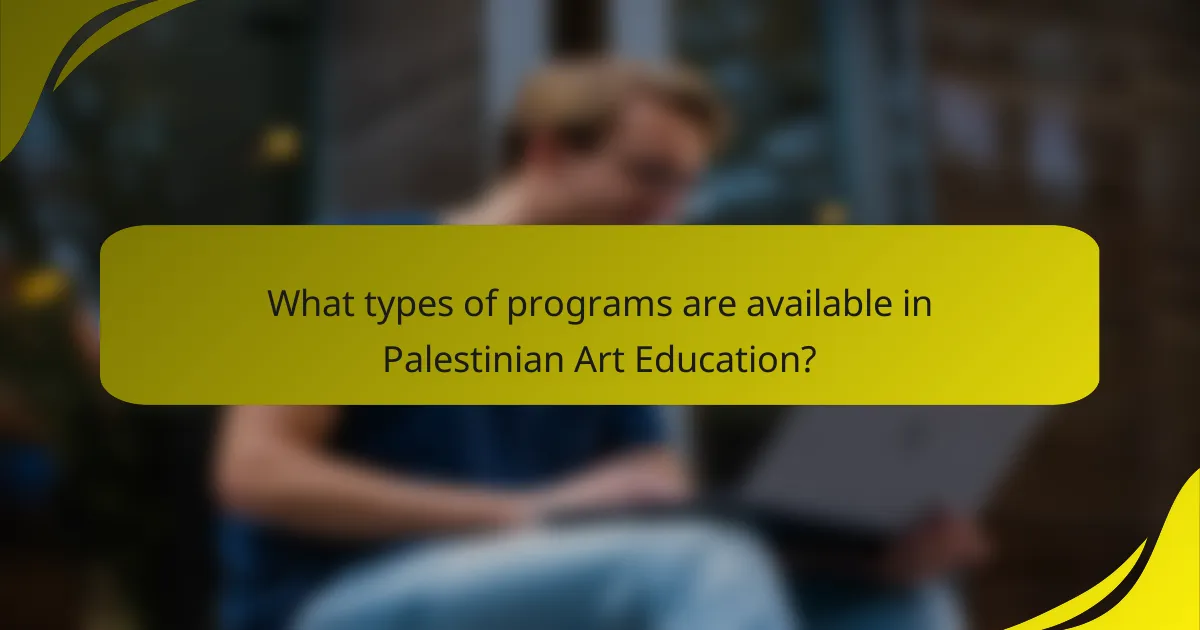
What types of programs are available in Palestinian Art Education?
Palestinian Art Education offers a variety of programs. These programs include visual arts, music, dance, and theater. Community art workshops are common, promoting local talent and cultural expression. Universities also provide formal art degrees, focusing on contemporary and traditional practices. Non-profit organizations often run outreach initiatives for youth engagement. Art therapy programs are available, addressing psychological well-being through creative expression. Additionally, international collaborations enhance cultural exchange and skill development. These diverse programs contribute to the preservation and evolution of Palestinian cultural identity.
How do formal art education programs differ from informal community workshops?
Formal art education programs are structured and accredited, while informal community workshops are more flexible and accessible. Formal programs typically offer a curriculum that includes theoretical and practical components. They often lead to recognized certifications or degrees. In contrast, community workshops focus on experiential learning and may not require prior knowledge or skills. These workshops often prioritize local culture and community engagement. Research indicates that formal education can provide deeper technical skills, while informal settings foster creativity and social connections. Both formats play vital roles in the artistic landscape, catering to different needs and goals.
What are the benefits of each type of program for participants?
Each type of program in Palestinian art education offers unique benefits for participants. Visual arts programs enhance creativity and self-expression among participants. Workshops provide hands-on experience, fostering practical skills in various art forms. Community engagement initiatives promote social cohesion and cultural awareness. Educational programs improve critical thinking and appreciation for art history. Collaborative projects encourage teamwork and communication among participants. These benefits contribute to personal development and community empowerment. Participants often report increased confidence and a sense of belonging through their involvement in these programs.
How do these programs cater to different age groups and skill levels?
These programs cater to different age groups and skill levels by offering tailored art education experiences. They provide age-specific workshops for children, teenagers, and adults. Each workshop is designed to accommodate varying skill levels, from beginners to advanced practitioners. For instance, children’s programs focus on basic techniques and creative expression. Teen workshops often introduce more complex concepts and mediums. [censured] classes may emphasize professional development and artistic refinement. Feedback from participants indicates that this approach fosters inclusivity and encourages participation across demographics. Programs also adapt materials and teaching methods to suit diverse learning styles. This flexibility ensures that all community members can engage meaningfully with the art education offered.
What partnerships exist to support Palestinian Art Education initiatives?
Various partnerships support Palestinian Art Education initiatives. Organizations such as the Al-Quds University and the International Academy of Art Palestine collaborate to enhance art education. Additionally, the A.M. Qattan Foundation provides funding and resources for art programs. The United Nations Relief and Works Agency (UNRWA) also supports initiatives aimed at fostering creativity among Palestinian youth. These partnerships focus on providing training, resources, and exposure to international art practices. They aim to empower local artists and educators through collaborative projects and exhibitions. Evidence of their impact can be seen in increased participation in art programs and community engagement activities.
How do collaborations with local and international organizations enhance program effectiveness?
Collaborations with local and international organizations enhance program effectiveness by pooling resources and expertise. These partnerships allow for a broader reach in communities. They enable access to diverse funding opportunities, which can amplify program impact. Collaborations also facilitate knowledge exchange between organizations. This exchange can lead to innovative practices in art education. For example, local organizations can gain insights from international best practices. Additionally, international organizations can better understand local needs through these partnerships. Such collaborations often lead to increased community engagement and participation. Research has shown that programs with collaborative frameworks report higher success rates.
What role do educational institutions play in these partnerships?
Educational institutions serve as vital facilitators in partnerships focused on Palestinian art education and community engagement. They provide resources and expertise to enhance art programs. These institutions often collaborate with local artists and organizations to create outreach initiatives. They also offer a platform for community members to engage in artistic expression. By integrating art into educational curricula, they foster creativity and cultural awareness. Research shows that such partnerships can improve social cohesion and community resilience. Educational institutions thus play a crucial role in promoting social impact through art education initiatives.
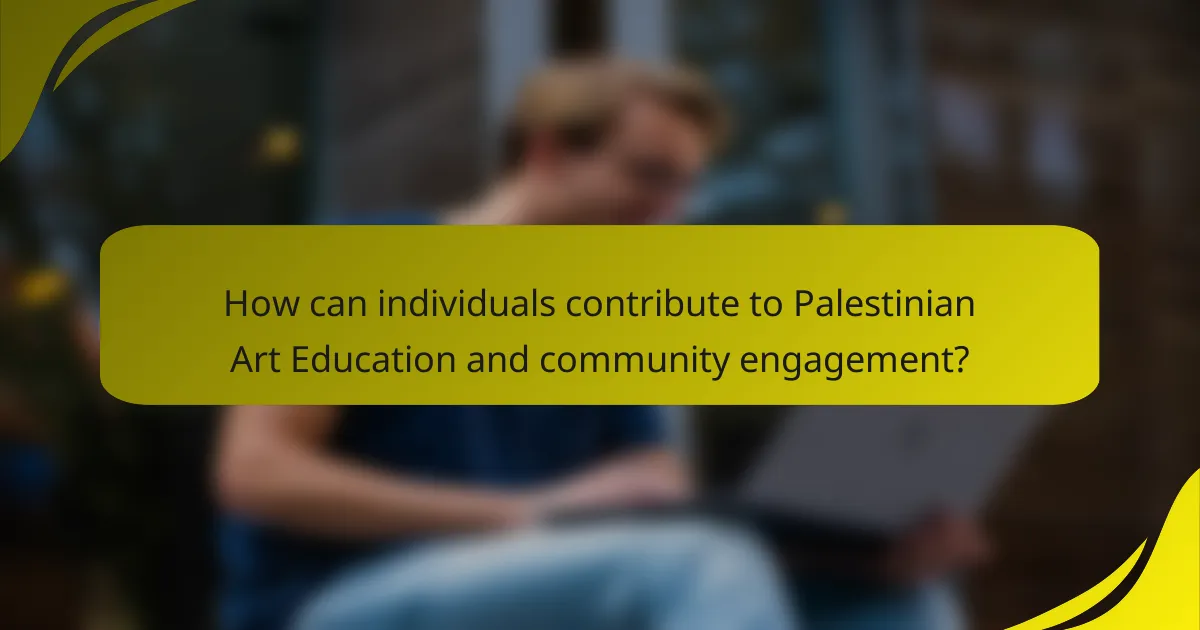
How can individuals contribute to Palestinian Art Education and community engagement?
Individuals can contribute to Palestinian Art Education and community engagement by volunteering their time and skills. They can offer workshops or classes in various art forms. Donations of art supplies to local organizations are also valuable. Supporting local artists through purchases or sponsorships fosters community growth. Individuals can promote Palestinian art through social media platforms. Collaborating with established art institutions enhances educational opportunities. Attending local art events raises awareness and builds community ties. Engaging in fundraising efforts helps sustain art programs and initiatives.
What volunteer opportunities are available in Palestinian art programs?
Volunteer opportunities in Palestinian art programs include assisting in workshops, teaching art classes, and organizing community events. Volunteers can help facilitate art therapy sessions for youth and marginalized groups. They may also support local artists by promoting their work and participating in exhibitions. Additionally, opportunities exist for creating educational materials and resources. Volunteers often collaborate with cultural organizations to enhance community engagement. These programs aim to foster creativity and provide a platform for expression. Participation can significantly impact social cohesion and cultural awareness within the community.
How can individuals support outreach initiatives financially or through resources?
Individuals can support outreach initiatives financially or through resources by donating funds, providing materials, or volunteering time. Financial contributions can help cover program costs, such as art supplies and venue rentals. For example, a donation of $100 can fund workshops for local artists. Providing materials, such as paint or canvases, directly supports the initiative’s activities. Volunteering time allows individuals to share skills and knowledge, enhancing the program’s effectiveness. Collaborative fundraising events can also raise awareness and generate additional resources. These actions collectively strengthen outreach initiatives and their impact on the community.
What best practices should be followed to ensure successful community engagement in art education?
Successful community engagement in art education involves fostering collaboration, inclusivity, and ongoing communication. Establish partnerships with local organizations to enhance outreach. Tailor programs to reflect community interests and cultural values. Create accessible art spaces that encourage participation from diverse groups. Utilize feedback mechanisms to continuously improve initiatives. Implement workshops that empower participants through hands-on experiences. Promote visibility of art education through community events and exhibitions. These practices have been shown to increase participation and strengthen community ties, as evidenced by successful programs in various cultural contexts.
How can feedback from participants be effectively integrated into program development?
Integrating feedback from participants into program development can be achieved through systematic collection and analysis. Regular surveys can capture participant insights about their experiences. Focus groups can facilitate in-depth discussions on program effectiveness. Feedback should be categorized into actionable themes to guide improvements. Implementing changes based on feedback demonstrates responsiveness and builds trust. Tracking the impact of these changes is essential for continuous improvement. Research shows that programs that actively solicit and incorporate participant feedback see higher satisfaction rates and better outcomes. For example, a study by the Center for Creative Leadership found that organizations that engage participants in feedback loops improve program relevance and effectiveness significantly.
What strategies can be employed to sustain community interest and involvement?
Engaging the community in Palestinian art education requires targeted strategies. Organizing regular workshops fosters hands-on participation. These workshops can showcase local artists and their techniques. Collaborating with schools enhances outreach to younger audiences. This approach encourages early interest in art education. Hosting community exhibitions allows participants to display their work. This recognition can motivate continued involvement. Utilizing social media platforms increases visibility and engagement. Sharing success stories can inspire others to join. Offering incentives, such as scholarships, can attract more participants. These strategies collectively sustain community interest and involvement in art initiatives.
Palestinian Art Education and Community Engagement encompasses initiatives that enhance artistic expression and cultural understanding within Palestinian communities. The article explores various programs that foster creativity, social cohesion, and community development through art, including workshops, exhibitions, and outreach initiatives. Key components such as curriculum development, community involvement, and resource access are examined, highlighting their impact on individual empowerment and cultural identity. Additionally, the article discusses the role of partnerships, volunteer opportunities, and best practices for sustaining community interest in art education, emphasizing the measurable social impact of these initiatives on Palestinian society.
